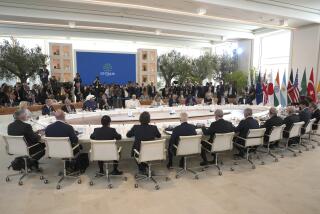U.S. Will Plot New Course at G-7 Meeting, Rubin Says : Policy: Measures will address the stabilization of international markets and heading off currency turmoil.
- Share via
WASHINGTON — The Clinton Administration will propose a series of measures today to stabilize the international economy and head off the sort of turmoil that has wracked the currency markets and shaken Mexico, Treasury Secretary Robert E. Rubin said Monday.
However, Rubin made it clear that the Administration is concentrating more on long-term changes rather than immediate action to shore up the dollar at today’s meeting of the finance ministers of the Group of Seven economic powerhouses. At the meeting, the Administration will emphasize what Rubin considers the strong fundamentals of the U.S. economy, in particular the deficit-reduction track on which he says the Administration is set.
Despite Rubin’s comments, the dollar gained strength Monday amid renewed speculation that the G-7 might make a concerted effort to boost the ailing U.S. currency. Traders speculated that the group might set a trading range for the dollar or create a plan to aid the currency, analysts said. That helped underpin the dollar for most of the day.
In late New York trading, the dollar was quoted at 83.03 Japanese yen, up from 82.70 on Friday. It rose to 1.3750 German marks from 1.3694.
Rubin is hosting the spring meeting of the G-7 finance ministers--made up of Britain, Canada, France, Germany, Italy, Japan and the United States--at a time of unusual discord within the group. In particular, Germany and Japan are worried that the falling dollar is making their products too expensive in the United States.
Michel Camdessus, chief of the International Monetary Fund, laid part of the blame for the dollar’s fall on a lack of coordination among the world’s major trading partners. Since the beginning of the year, the U.S. currency has lost about 20% of its value against the yen, although it has climbed back a few points in the past week. It has lost approximately 10% of its value against the mark.
What is needed, Rubin said at a news conference, is “a financial architecture that is as modern as the financial markets and the challenges of today’s world economy.”
He warned that Japan’s recovery is in jeopardy and that high unemployment in Europe underlines the need to remove economic barriers to the creation of more jobs.
“While some of these issues seem remote, how they are resolved will dramatically and directly affect growth in the United States and the jobs, living standards and future prospects of the American people,” Rubin said.
Among his proposals:
* Creation of an early-warning system that will signal government financial officials, through the disclosure of monetary and financial data, that significant and possibly destabilizing shifts are occurring in the markets.
* Establishment of an emergency financing operation to provide large amounts of capital to support such suddenly struggling economies as Mexico’s. The announcement in January that the IMF would provide about $20 billion to help Mexico stabilize its economy followed an extraordinarily speedy decision-making process--considered an exception that the Administration would like to see become a rule.
* Development of a system of cooperation in major financial centers to guard against the sorts of emergencies that arise when billions of dollars can change hands in seconds.
The results of the meeting could have an immediate impact. If the participants walk away from the session in disarray, it would shake the confidence of the global currency markets and probably put more downward pressure on the dollar.
Rubin listed five major changes that have taken place in recent years in financial markets: the speed with which capital moves from country to country, the sudden flows of money out of particular markets, the new instruments of investment, the increasing numbers of investors and the new destinations--mostly in the developing world--for investment capital.
* ANOTHER DOW RECORD
Stocks shot up to a record high, surpassing the 4,300 mark. D2
More to Read
Inside the business of entertainment
The Wide Shot brings you news, analysis and insights on everything from streaming wars to production — and what it all means for the future.
You may occasionally receive promotional content from the Los Angeles Times.










